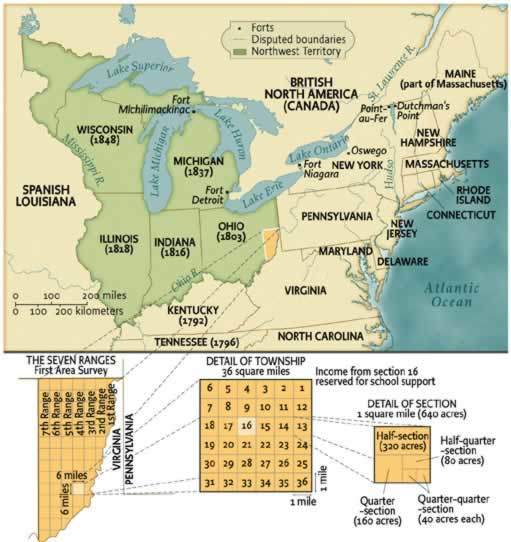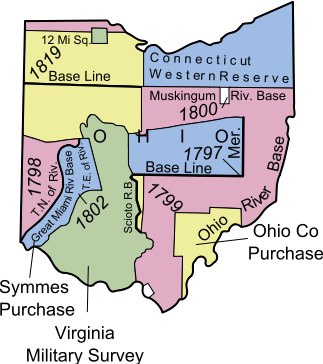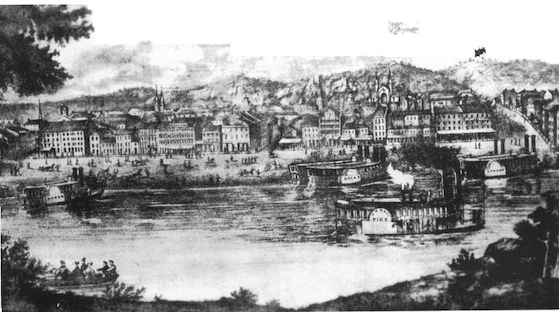The Northwest Ordinance of 1787 and its Effects
Dan Bryan, April 8 2012
 Map of the Northwest Territory, including a depiction of the Township system
Map of the Northwest Territory, including a depiction of the Township systemIn its brief existence, the Confederation Congress passed little legislation of lasting import. One of the few exceptions was the Northwest Ordinance of 1787, which controlled the admission of the Midwest states and laid the legal groundwork for their functioning.
One of Thomas Jefferson's often overlooked accomplishments is the work that he devoted to this plan. Less renowned but equally important advocates were Nathan Dane and Rufus King.
The ordinance applied to the Northwest Territory, which consisted of the entire Midwest located east of the Mississippi River.
Overview of the Northwest Ordinance
Admission of new states
It had been decided in other acts that the western areas of the United States should be admitted as separate states, and that the currently admitted states would not be allowed to expand.
The Northwest Ordinance laid out the details of the admission process. When a territory reached 60,000 people it could create a constitution and apply for statehood. This procedure was first applied to Ohio in 1803, and served as a continuing model for the remainder of the United States.
Voting rights and office-holding
Any man who owned fifty acres of property in the Northwest Territory was entitled to a vote. More property had to be owned in order to qualify for service in government. These restrictions were commonplace for the United States before the age of Jackson, and designed to restrict the influence of popular passions in the functioning of the new republic.
Slavery forbidden in the Northwest Territory
Slavery and involuntary servitude were forbidden in the Northwest Territory, thereby making the Ohio River a natural dividing line between the free and slave states of the country.
Unanimous consent from the states was required for the Northwest Ordinance to be passed. Thus one might ask -- why did the southern states agree to this provision?
There are a couple main reasons. First of all, under the Articles of Confederation, the power of the national government to potentially curtail slavery in the southern states was almost nonexistent. The paranoia that would later define the balance of free and slave states was not yet in full force. Slavery being established in Kentucky and Tennessee, it was also obvious that the remainder of the south would be allowed to adopt that practice without issue.
Secondly, the primary crop of most plantations at that time was tobacco. This was a crop that could only be grown profitably with the assistance of slave labor. By outlawing slave labor in the Midwest, the southern planters protected themselves from economic competition (and indeed, after the Civil War some tobacco was eventually grown in the Midwest).
Even though he himself lived in luxury with the aid of slave labor, Jefferson was (sometimes) keen to stop the spread of slavery, and he worked to keep it out of the Northwest Territory.
Individual rights preserved
Many of the guarantees enshrined in the Constitution and the Bill of Rights were anticipated by the Northwest Ordinance.
- Freedom of religion
- Habeas corpus
- The right to bail and trial by jury
- No cruel and unusual punishment
- Right to enter freely into private contracts
- Right to compensation for eminent domain
It is not difficult to see the commonalities between these two documents.
The Northwest Ordinance and Land Ownership
Surveying and division of the land
The Northwest Territory was the first part of the United States to be surveyed under the Public Land Survey System. Land was divided into townships -- measuring 6 miles square. Townships were each divided into 36 sections of a mile square (640 acres). From this point land could be subdivided into smaller lots ("half lots" (320 acres), "quarter lots" (160 acres), and "quarter-quarter lots" (40 acres) were some terms used).
Each township was required to maintain one section for public buildings and education.
The influence of men like Thomas Jefferson can clearly be seen in this system. The purpose of such small lots was to avoid the concentration of land ownership, and to promote Jefferson's vision of an agrarian republic.
Public land sales
The national government as well as most state governments owed a large debt to the veterans of the Revolutionary War. In many cases, land was given to them in lieu of back pay, which helped ease the massive deficit that the new government was facing. Wealthier veterans and outright speculators acquired larger plots and sold pieces of them to newer arrivals.
 A number of different groups obtained land in Ohio after the Northwest Ordinance
A number of different groups obtained land in Ohio after the Northwest OrdinanceThe influx of war veterans left its mark upon Ohio. For example, Cincinnati was named by General Anthony St. Clair after the Society of the Cincinnati. This was a group of Continental Army officers -- led by George Washington -- who reaffirmed their commitment to the rights and liberties of the Revolution over the lure of power and fame, based on the example of the Roman general Cincinnatus.
Northwest Indian War
The Shawnee and Miami tribes opposed the new plans and attacked white settlers as they moved into Ohio. At first, they were successful. Two different militias were raised and sent after the Indian tribes, but both of them were defeated at a coast of 800 dead Americans.
President Washington then became involved, raising a larger federal army and sending it into the area, under the command of "Mad Anthony" Wayne. This army was more successful, winning a decisive victory at Fallen Timbers in 1794. The result was the Treaty of Greenville, in which the Shawnee and others ceded their claim to most of Ohio.
As settlements pushed to the west, similar conflicts were fought in the 1800s, such as the Black Hawk War in Illinois.
The Legacy of the Northwest Ordinance
In their objective of promoting egalitarianism, the creators of the Northwest Ordinance were largely successful. In spite of speculation and the inevitable abuses, the ownership of land was spread quite evenly across the Midwest, with fewer of the massive estates that came to dominate the southern and eastern regions.
 By 1840, Cincinnati was a bustling inland city. Kentucky remained a backwater.
By 1840, Cincinnati was a bustling inland city. Kentucky remained a backwater.The wisdom of abolition was clearly seen in the relative prosperity of the Midwest. On his tour of the United States -- nearly fifty years after the Ordinance -- Alexis de Tocqueville discoursed at length about the differences between Ohio and Kentucky. This article concludes with his prescient words:
"The State of Ohio is separated from Kentucky just by one river; on either side of it the soil is equally fertile, and the situation equally favorable, and yet everything is different.
Here (in Ohio) a population devoured by feverish activity, trying every means to make its fortune; the population seems poor to look at, for they work with their hands, but that work is the source of riches. There (in Kentucky) is a people which makes others work for it and shows little compassion, a people without energy, mettle or the spirit of enterprise...
The population of Kentucky, which has been peopled for nearly a century, grows slowly. Ohio only joined the Confederation thirty years ago and has a million inhabitants. Within those thirty years Ohio has become the entrepot for the wealth that goes up and down the Mississippi; it has opened two canals and joined the Gulf of Mexico to the North Coast; meanwhile Kentucky, older and perhaps better placed, stood still.
These differences cannot be attributed to any other cause but slavery. It degrades the black population and enervates the white. Its fatal effects are recognized, and yet it is preserved and will be preserved for a long time more..."
